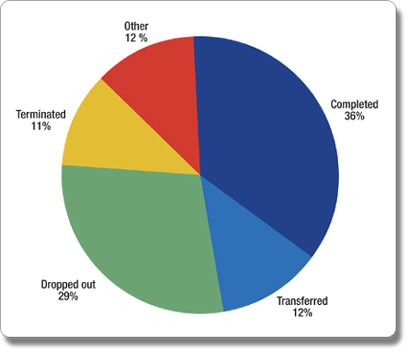Discharges from Treatment: Latest
Report Released
A new SAMHSA report, Treatment
Episode Data Set (TEDS) 2005: Discharges
from Substance Abuse Treatment Services,
is shedding new light on treatment
completion rates, length of stay, and
characteristics of approximately 1.5
million discharges from alcohol or
drug treatment facilities.
This report, the latest in a series of yearly updates,
provides overall figures for the 34 states that report
discharge data to TEDS.
It also breaks this information down into a variety
of criteria—including client characteristics
and length of stay—that can help provide greater
perspective on the experiences of those who have undergone
substance abuse treatment.
Back
to Top
Notable Findings
The largest age groups among all treatment discharges
were age 31 to 40 (29 percent), age 21 to 30 (26 percent),
and age 41 to 50 (25 percent). Fourteen percent were
under age 21. However, the most common group for initiating
use of their primary substance was between 15 and 17
years.
Alcohol was the most common primary substance, reported
by 39 percent of discharges. The strongest predictor
of treatment completion was the use of alcohol rather
than other drugs. Clients discharged from all types
of service combined were 82 percent more likely to
complete treatment or transfer to further treatment
if their primary substance was alcohol, after taking
into account all other characteristics.
The treatment completion rate was highest among clients
discharged from hospital residential treatment (67
percent), detoxification (65 percent), and short-term
residential treatment (56 percent). Treatment completion
rates were lower in longer-term and less-structured
settings.
Not counting discharges receiving opioid replacement
therapy (methadone), the median length
of stay in treatment was greatest
for discharges from outpatient treatment
(76 days), followed by long-term
residential treatment (53 days) and
intensive outpatient treatment (46 days).
The report presents data on the reasons for discharge
for 592,057 clients in outpatient
treatment in 2005 in 33 states (see
chart below).
Reasons clients left treatment:
Completed treatment (36 percent) Dropped out of
treatment (29 percent) Transferred
to further treatment (12 percent) Had
treatment terminated by the facility
(11 percent) Failed to complete
for other reasons (12 percent).
Back
to Top
Why Patients Leave Outpatient Treatment
TEDS is an episode-based system, and its figures for
discharges do not directly correspond to the number
of individuals discharged from treatment programs in
a given year. For example, one individual who had undergone
treatment twice during the same year would be counted
as two discharges in the TEDS report.
To access the TEDS 2005 discharges report online,
visit wwwdasis.samhsa.gov/teds05/tedsd2k5index.htm.
For a print copy, contact SAMHSA’s Health Information
Network at 1-877-SAMHSA-7 (1-877-726-4727)
or 1-800-487-4889 (TDD). Request inventory number SMA08-4314. 
« Previous Article
Next
Article »
Back
to Top
|

 d
d